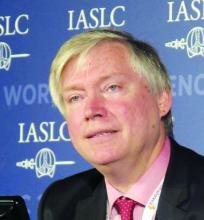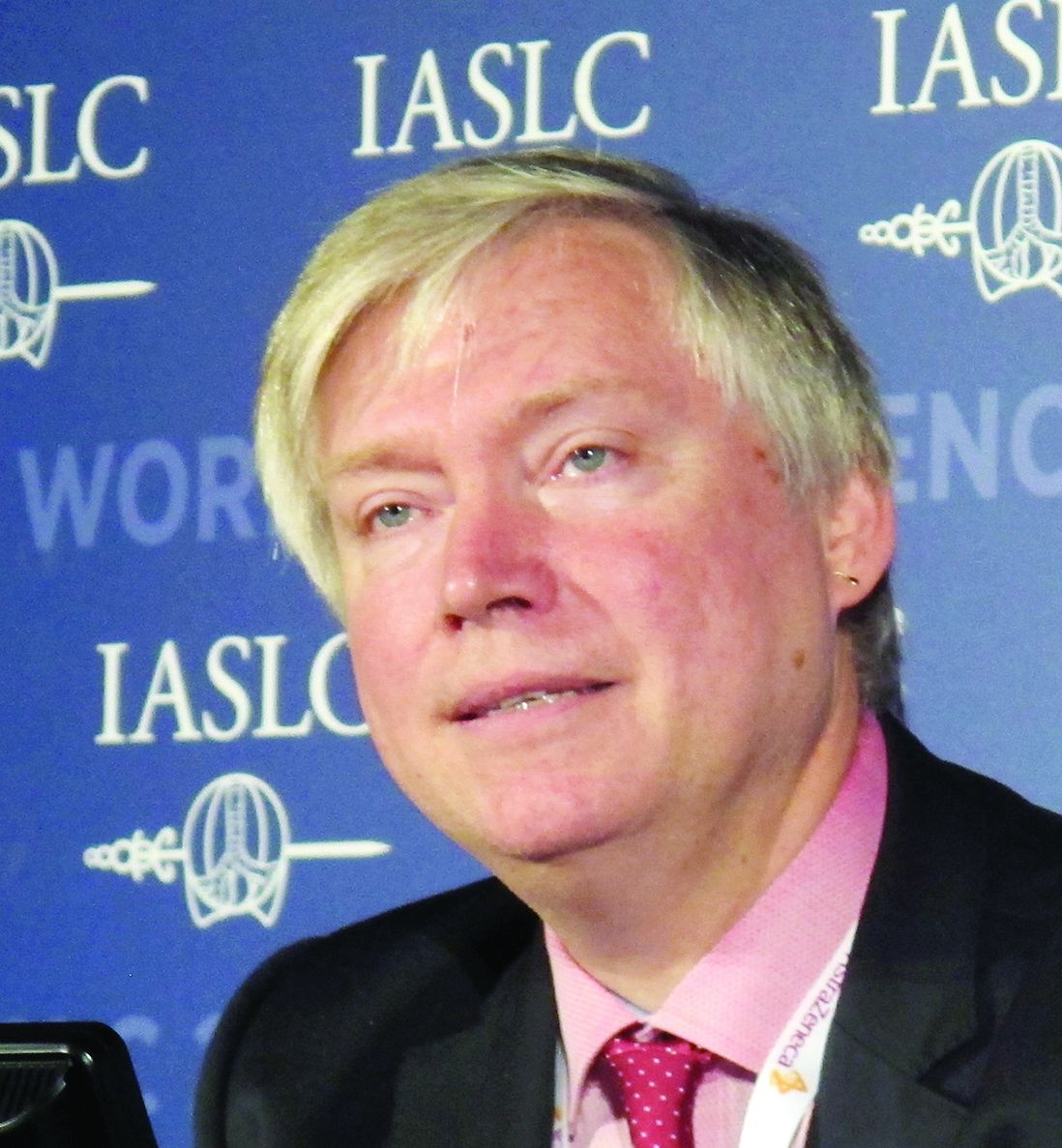User login
BARCELONA – First-line pembrolizumab provides a durable long-term overall survival (OS) benefit, compared with that of chemotherapy, in patients with advanced nonsquamous non–small cell lung cancer (NSCLC), according to 3-year data from the phase 3 Keynote-024 trial.
As previously reported, first-line treatment with the programmed death-1 (PD-1) inhibitor significantly improved progression-free survival (PFS) and OS, compared with those of platinum-based chemotherapy, and had fewer adverse events after a median of 11.2 months of follow-up in the open-label trial. In 305 patients with advanced NSCLC, high PD-L1 expression, and an absence of targetable epidermal growth factor or anaplastic lymphoma kinase gene alterations, median PFS was 10.3 months vs. 6.0 months, and estimated OS was 80.2% vs. 72.4% in the groups, respectively (hazard ratios, 0.50 and 0.60, respectively).
At 3 years after treatment initiation, median OS was 26.3 months vs. 14.2 months in patients treated with pembrolizumab or chemotherapy (HR, 0.65), respectively, and the OS rates were 43.7% and 24.9%, Martin Reck, MD, reported at the World Conference on Lung Cancer.
This was despite 98 of 151 patients assigned to chemotherapy crossing over to pembrolizumab, Dr. Reck, head of the department of thoracic oncology and the clinical trial department in the department of thoracic oncology at the Lung Clinic Grosshansdorf (Germany), noted at the conference, which was sponsored by the International Association for the Study of Lung Cancer.
Additionally, despite longer mean treatment duration in the pembrolizumab arm than in the chemotherapy arm (11.1 vs. 4.4 months), grade 3-5 treatment-related adverse events were less frequent with pembrolizumab than with chemotherapy (31.2% vs. 53.3%), he said.
Of 38 patients in the pembrolizumab arm who completed 2 years of therapy, 34 were alive at 3 years, and 31 (81.6%) had an objective response, including 2 who had a complete response. Median duration of response was not reached, and OS was 97.4%.
Grade 3-5 adverse events occurred in 5 (13.2%) of those patients; no fatal treatment-related adverse events occurred.
Of note, 7 of 10 patients who completed 2 years of treatment, but who subsequently progressed, experienced an objective response with a second course of pembrolizumab, and 8 remain alive, he said.
Patients in KEYNOTE-024 were randomized to receive 200 mg of pembrolizumab every 3 weeks for 2 years or investigator’s choice of platinum doublet for 4-6 cycles plus optional maintenance, with stratification by performance status, tumor histology, and region.
The findings confirm the long-term efficacy of pembrolizumab, compared with platinum-based chemotherapy, demonstrate “consistent benefit in overall survival ... despite a crossover of 65%,” and show the first signs of efficacy with reexposure to pembrolizumab at the time of progression.
“This is work in progress; currently we have data from 10 [reexposed] patients, but what we do see is clinical activity even after [reexposure] to pembrolizumab, so we do see a stabilization of response to the disease in 70% of the patients, and 50% are ongoing.”
The findings highlight a new reality: “There are really some patients who have this disease as a chronic disease induced by immunotherapy.” Dr. Reck said.
KEYNOTE-024 was funded by Merck Sharp & Dohme. Dr. Reck reported receiving personal fees/honoraria for consultancy and lectures from Amgen, AstraZeneca, Bristol-Myers Squibb, Boehringer Ingelheim, Celgene, Merck Sharp & Dohme, MSD, Eli Lilly, Pfizer, AbbVie, Roche, and Novartis.
SOURCE: Reck M et al. WCLC 2019, Abstract OA14.01.
BARCELONA – First-line pembrolizumab provides a durable long-term overall survival (OS) benefit, compared with that of chemotherapy, in patients with advanced nonsquamous non–small cell lung cancer (NSCLC), according to 3-year data from the phase 3 Keynote-024 trial.
As previously reported, first-line treatment with the programmed death-1 (PD-1) inhibitor significantly improved progression-free survival (PFS) and OS, compared with those of platinum-based chemotherapy, and had fewer adverse events after a median of 11.2 months of follow-up in the open-label trial. In 305 patients with advanced NSCLC, high PD-L1 expression, and an absence of targetable epidermal growth factor or anaplastic lymphoma kinase gene alterations, median PFS was 10.3 months vs. 6.0 months, and estimated OS was 80.2% vs. 72.4% in the groups, respectively (hazard ratios, 0.50 and 0.60, respectively).
At 3 years after treatment initiation, median OS was 26.3 months vs. 14.2 months in patients treated with pembrolizumab or chemotherapy (HR, 0.65), respectively, and the OS rates were 43.7% and 24.9%, Martin Reck, MD, reported at the World Conference on Lung Cancer.
This was despite 98 of 151 patients assigned to chemotherapy crossing over to pembrolizumab, Dr. Reck, head of the department of thoracic oncology and the clinical trial department in the department of thoracic oncology at the Lung Clinic Grosshansdorf (Germany), noted at the conference, which was sponsored by the International Association for the Study of Lung Cancer.
Additionally, despite longer mean treatment duration in the pembrolizumab arm than in the chemotherapy arm (11.1 vs. 4.4 months), grade 3-5 treatment-related adverse events were less frequent with pembrolizumab than with chemotherapy (31.2% vs. 53.3%), he said.
Of 38 patients in the pembrolizumab arm who completed 2 years of therapy, 34 were alive at 3 years, and 31 (81.6%) had an objective response, including 2 who had a complete response. Median duration of response was not reached, and OS was 97.4%.
Grade 3-5 adverse events occurred in 5 (13.2%) of those patients; no fatal treatment-related adverse events occurred.
Of note, 7 of 10 patients who completed 2 years of treatment, but who subsequently progressed, experienced an objective response with a second course of pembrolizumab, and 8 remain alive, he said.
Patients in KEYNOTE-024 were randomized to receive 200 mg of pembrolizumab every 3 weeks for 2 years or investigator’s choice of platinum doublet for 4-6 cycles plus optional maintenance, with stratification by performance status, tumor histology, and region.
The findings confirm the long-term efficacy of pembrolizumab, compared with platinum-based chemotherapy, demonstrate “consistent benefit in overall survival ... despite a crossover of 65%,” and show the first signs of efficacy with reexposure to pembrolizumab at the time of progression.
“This is work in progress; currently we have data from 10 [reexposed] patients, but what we do see is clinical activity even after [reexposure] to pembrolizumab, so we do see a stabilization of response to the disease in 70% of the patients, and 50% are ongoing.”
The findings highlight a new reality: “There are really some patients who have this disease as a chronic disease induced by immunotherapy.” Dr. Reck said.
KEYNOTE-024 was funded by Merck Sharp & Dohme. Dr. Reck reported receiving personal fees/honoraria for consultancy and lectures from Amgen, AstraZeneca, Bristol-Myers Squibb, Boehringer Ingelheim, Celgene, Merck Sharp & Dohme, MSD, Eli Lilly, Pfizer, AbbVie, Roche, and Novartis.
SOURCE: Reck M et al. WCLC 2019, Abstract OA14.01.
BARCELONA – First-line pembrolizumab provides a durable long-term overall survival (OS) benefit, compared with that of chemotherapy, in patients with advanced nonsquamous non–small cell lung cancer (NSCLC), according to 3-year data from the phase 3 Keynote-024 trial.
As previously reported, first-line treatment with the programmed death-1 (PD-1) inhibitor significantly improved progression-free survival (PFS) and OS, compared with those of platinum-based chemotherapy, and had fewer adverse events after a median of 11.2 months of follow-up in the open-label trial. In 305 patients with advanced NSCLC, high PD-L1 expression, and an absence of targetable epidermal growth factor or anaplastic lymphoma kinase gene alterations, median PFS was 10.3 months vs. 6.0 months, and estimated OS was 80.2% vs. 72.4% in the groups, respectively (hazard ratios, 0.50 and 0.60, respectively).
At 3 years after treatment initiation, median OS was 26.3 months vs. 14.2 months in patients treated with pembrolizumab or chemotherapy (HR, 0.65), respectively, and the OS rates were 43.7% and 24.9%, Martin Reck, MD, reported at the World Conference on Lung Cancer.
This was despite 98 of 151 patients assigned to chemotherapy crossing over to pembrolizumab, Dr. Reck, head of the department of thoracic oncology and the clinical trial department in the department of thoracic oncology at the Lung Clinic Grosshansdorf (Germany), noted at the conference, which was sponsored by the International Association for the Study of Lung Cancer.
Additionally, despite longer mean treatment duration in the pembrolizumab arm than in the chemotherapy arm (11.1 vs. 4.4 months), grade 3-5 treatment-related adverse events were less frequent with pembrolizumab than with chemotherapy (31.2% vs. 53.3%), he said.
Of 38 patients in the pembrolizumab arm who completed 2 years of therapy, 34 were alive at 3 years, and 31 (81.6%) had an objective response, including 2 who had a complete response. Median duration of response was not reached, and OS was 97.4%.
Grade 3-5 adverse events occurred in 5 (13.2%) of those patients; no fatal treatment-related adverse events occurred.
Of note, 7 of 10 patients who completed 2 years of treatment, but who subsequently progressed, experienced an objective response with a second course of pembrolizumab, and 8 remain alive, he said.
Patients in KEYNOTE-024 were randomized to receive 200 mg of pembrolizumab every 3 weeks for 2 years or investigator’s choice of platinum doublet for 4-6 cycles plus optional maintenance, with stratification by performance status, tumor histology, and region.
The findings confirm the long-term efficacy of pembrolizumab, compared with platinum-based chemotherapy, demonstrate “consistent benefit in overall survival ... despite a crossover of 65%,” and show the first signs of efficacy with reexposure to pembrolizumab at the time of progression.
“This is work in progress; currently we have data from 10 [reexposed] patients, but what we do see is clinical activity even after [reexposure] to pembrolizumab, so we do see a stabilization of response to the disease in 70% of the patients, and 50% are ongoing.”
The findings highlight a new reality: “There are really some patients who have this disease as a chronic disease induced by immunotherapy.” Dr. Reck said.
KEYNOTE-024 was funded by Merck Sharp & Dohme. Dr. Reck reported receiving personal fees/honoraria for consultancy and lectures from Amgen, AstraZeneca, Bristol-Myers Squibb, Boehringer Ingelheim, Celgene, Merck Sharp & Dohme, MSD, Eli Lilly, Pfizer, AbbVie, Roche, and Novartis.
SOURCE: Reck M et al. WCLC 2019, Abstract OA14.01.
REPORTING FROM WCLC 2019

